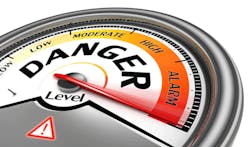I think we can agree that we equally are vulnerable when it comes to maintaining our safety. No matter the safety programs your employer uses or your individual perception of what constitutes safety, understand that the ultimate responsibility for your safety rests with you.
Heinrich, back in 1931, attributed 88 percent of all accidents to unsafe acts. The actual number may be closer to 100 percent when you take a hard look at unsafe conditions and find that many of them are the result of human actions or inaction.
I believe that we have a problem when it comes to keeping people safe. Despite the everyday bumps and bruises, many of us continue to believe that everything is okay, even though we can’t seem to stop accidents from occurring.
We always can do more to improve safety performance, something safety professionals work at every day, and constantly are frustrated that accidents keep occurring despite their best efforts. As a safety professional, I felt that frustration for many years.
As I look back over the early days of my work life, I’m amazed at how little “safety” was even mentioned. You were hired and went to work, with little or no safety orientation.
I never got hurt or witnessed anyone else get hurt until my next-to-last job in industry as an environmental and safety manager. Two employees suffered severe injuries – one a crushed hand – and the other a severely lacerated hand. Even with safe operating procedures in place and the presence of machine guarding, both endured significant lost workday injuries as a result of miscommunication in one instance, and an attempt to override machine guarding in the other.
Having retired as a full-time safety professional, I’m no longer frustrated on a day-to-day basis by recurring accidents and incidents and now can look at safety with more objectivity, and offer what I believe to be an unbiased view of the reasons for accidents and why safety does not always mean safe.
Experience has convinced me that just about all accidents and incidents are the result of some form of human error. While employers are required by law to provide a safe working environment and can be cited for not doing so, unsafe/hazardous conditions that lead to accidents and incidents often can be traced to actions or inactions on the part of individuals.
This can include failure to report or correct an unsafe condition, failure to take required precautions or ineffective or improper equipment maintenance. When the prevailing impression is that we don’t need to concern ourselves about safety because the “safety people” will keep us safe, we are misleading ourselves.
The key word when it comes to safety is RISK. Risk is a measure of the consequences of our actions. More specifically, in terms of safety, it tells us how severely a hazard can impact us. Risks posed by hazards or unsafe conditions in the workplace can be evaluated. To accurately evaluate risk, you need to compile a complete list of all of the possible hazards that can be encountered in the workplace.
Then, ask a cross-section of the workforce to evaluate the risk of each hazard. This is done by rating the severity of potential outcome (from negligible (1) to catastrophic (4)); calculating the probability of the hazard occurring (from highly unlikely (1) to will occur frequently (5)); and evaluating the potential for exposure to the hazard (from few employees (1) to many employees (3)). Add the three numbers to produce a “risk factor” for each hazard. Decide what level of risk you can live with, and establish methods to lower the risk of the most hazardous first.
And remember, just eight causes account for nearly all accidents and incidents: overexertion; struck by person or object; struck against person or object; slips/trips/falls; caught in or between; ergonomic/repetitive motion; contact with; and moving equipment. Before there is a cause, there is, more often than not, a risk factor that was ignored.
I speak from the viewpoint of a former manager of safety compliance for a large company that received many national, corporate, regional and local safety awards, but still could never get anywhere close to “zero accidents.”
You can’t completely eliminate every lapse in judgment made by employees. But by evaluating risks and encouraging employees to be aware of their work conditions and the way they do their jobs, you can minimize the number of safety lapses that can lead to injuries and illnesses.
People are imperfect, make mistakes, take chances, take shortcuts, don’t think before they act and can contribute to most accidents and incidents. The solution? Address the reasons for accidents by raising your awareness of workplace risks.
Being safety aware is the most effective approach to improving workplace safety.
Joseph Werbicki is a Safety Consultant/Safety Trainer with over 30 years of safety management experience. He can be reached at [email protected] or 774-991-3945.
About the Author
Joseph Werbicki
Joseph Werbicki has an A.B. in chemistry from Brown University, an M.S. in chemistry from Northeastern University and has completed graduate work at the University of Maryland. Now retired, he served as manager of safety compliance at General Dynamics C4 Systems, Taunton, Mass.; environmental/safety manager at Copperweld Corp.; and as technical director at Agmet Corp. He’s presented at a number of safety conferences and had more than 40 articles published in national scientific journals.
